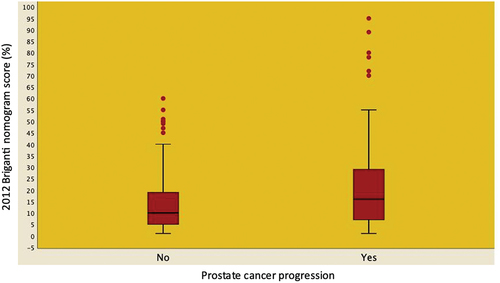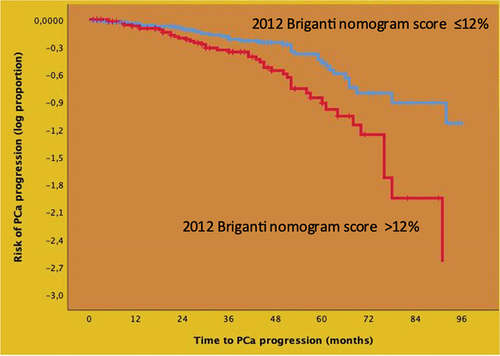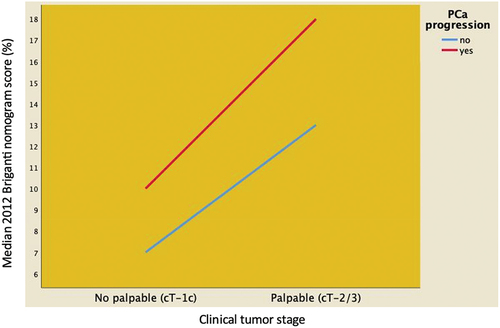Figures & data
Table 1. Descriptive statistics of the study population stratified according to the 2102 Briganti nomogram score (≤12% vs. >12%) and logistic regression models testing the association of clinical and pathological factors with the 2012 Briganti nomogram score.
Figure 1. Box and whisker plots illustrating the distribution of the 2012 Briganti nomogram score predicting lymph node invasion stratified according to the occurrence of disease progression in 204 EAU high-risk patients treated with radical prostatectomy and extended pelvic lymph node dissection. Median risk score was significantly higher in patients experiencing disease progression compared to those who did not progress (16.0, IQR: 7.0–29.5 vs. 10.0, IQR 5.0–19.0; OR: 1.03; 95%CI: 1.01–1.04; p <0.001).

Figure 2. Kaplan-Meier plots depicting prostate cancer (PCa) progression – free survival in 204 EAU high – risk patients treated with robot-assisted radical prostatectomy and extended pelvic lymph node dissection according to the 2012 Briganti nomogram score (up to the median vs. above the median). Median PCa progression free survival was higher in patients exhibiting a score ≤ 12% (67.0, IQR: 59.1–4.3 months) compared to those exhibiting a score > 12% (52.0, IQR: 44.6–59.3 months) with the difference being statistically significant (Mantel-Cox log rank test: p < 0.001; univariable hazard ratio: 1.87, 95% CI: 1.21–2.87; p = 0.005).

Figure 3. Distribution of median 2012 Briganti nomogram score predicting pelvic lymph node invasion stratified according to clinical tumor stage (palpable vs. not palpable tumors) and disease progression in 204 EAU high-risk prostate cancer patients treated with robot-assisted radical prostatectomy and extended pelvic lymph node invasion. Median 2012 Briganti nomogram score was higher in progressing patients, independently by clinical tumor stage.

Table 2. Cox regression models testing the 2012 Briganti nomogram as a predictor of disease progression after surgery in 204 EAU high-risk prostate cancer (PCa) patients treated with robot-assisted radical prostatectomy and extended pelvic lymph node dissection.
Table 3. Summary of the prognostic impact of the 2012 Briganti nomogram score on prostate cancer progression in 204 EAU high-risk prostate cancer patients treated with robot-assisted radical prostatectomy and extended pelvic lymph node.
Data availability statement
All data generated or analyzed during this study are included in this article. Further enquires can be directed to the corresponding author.
